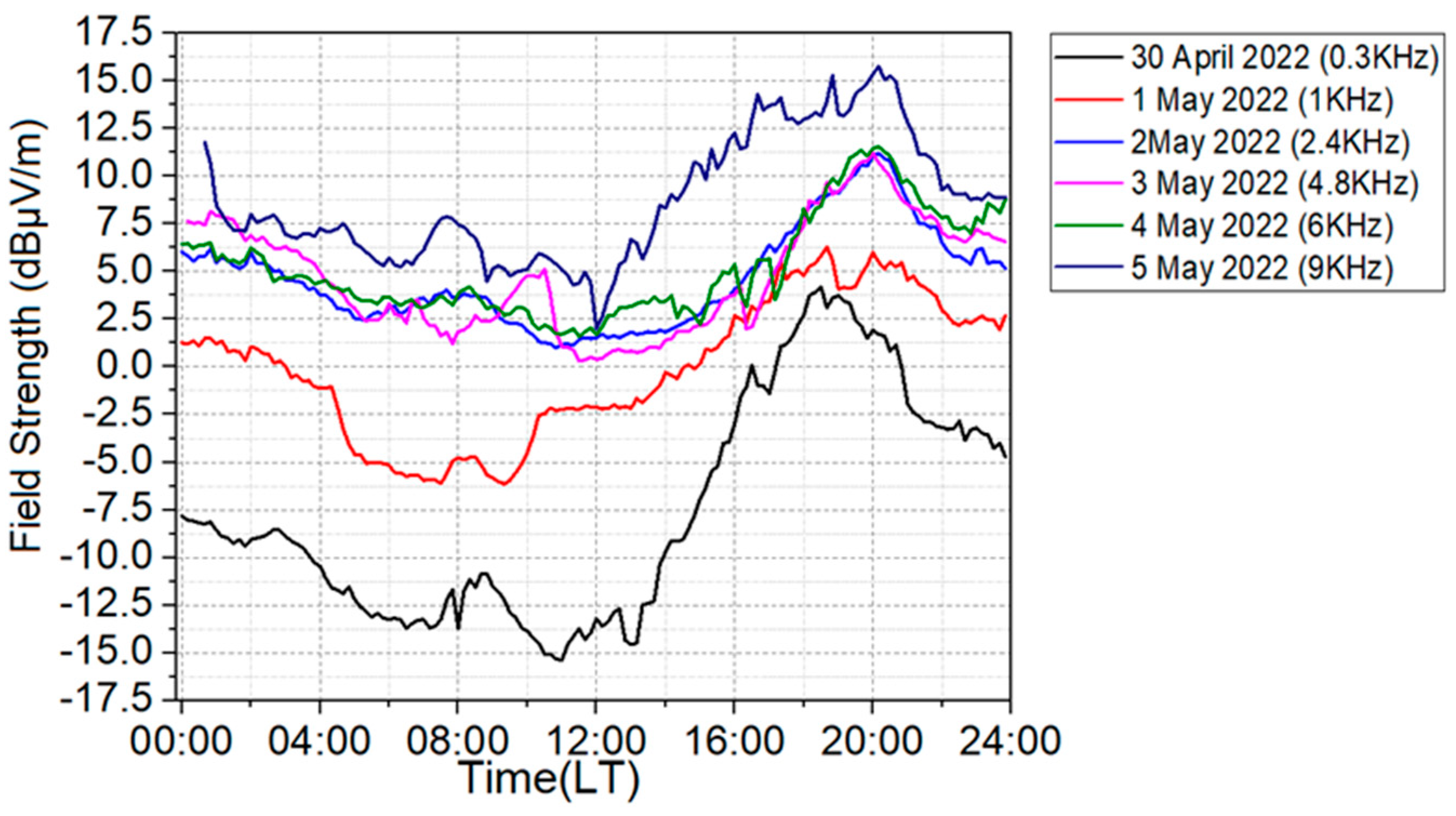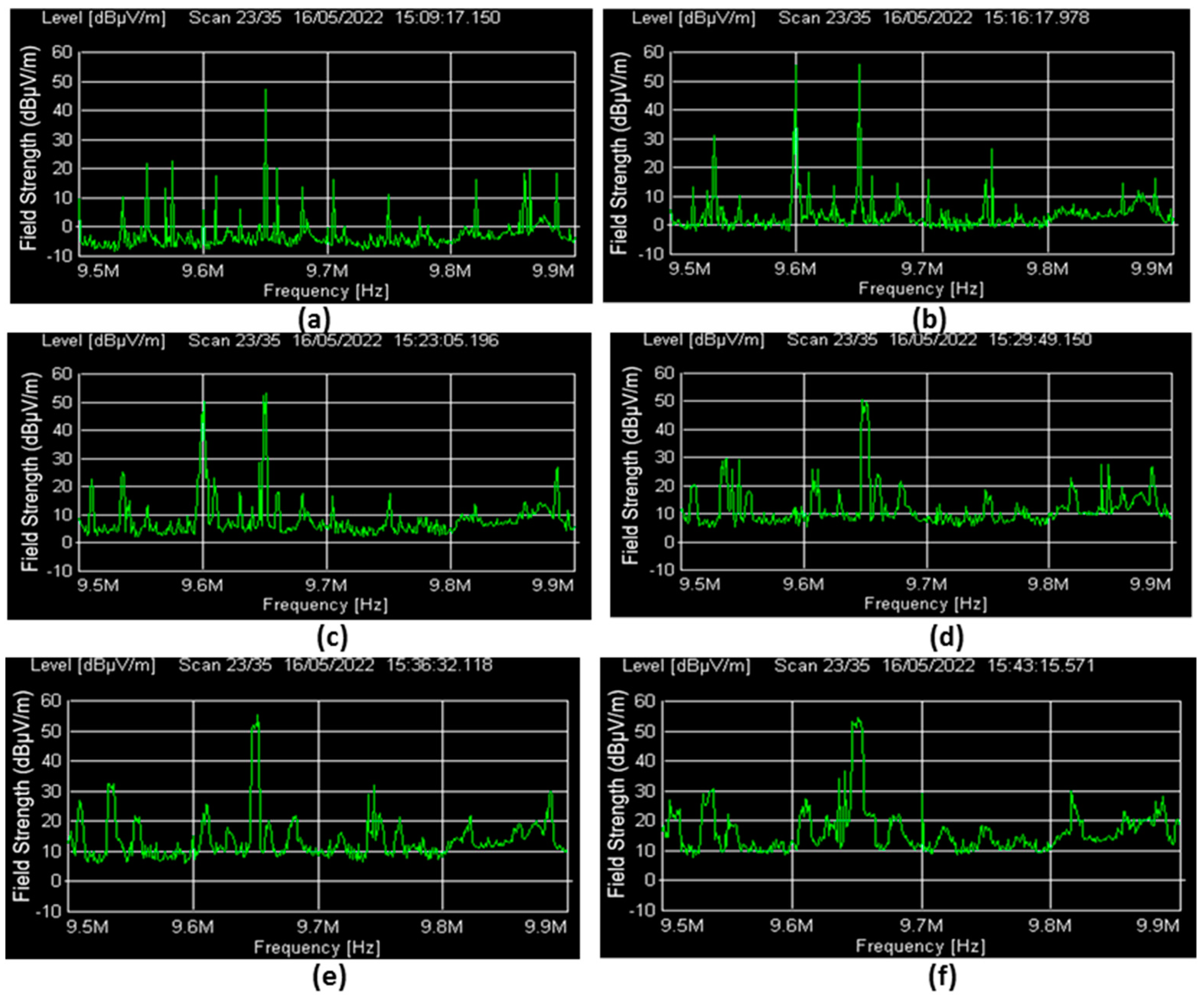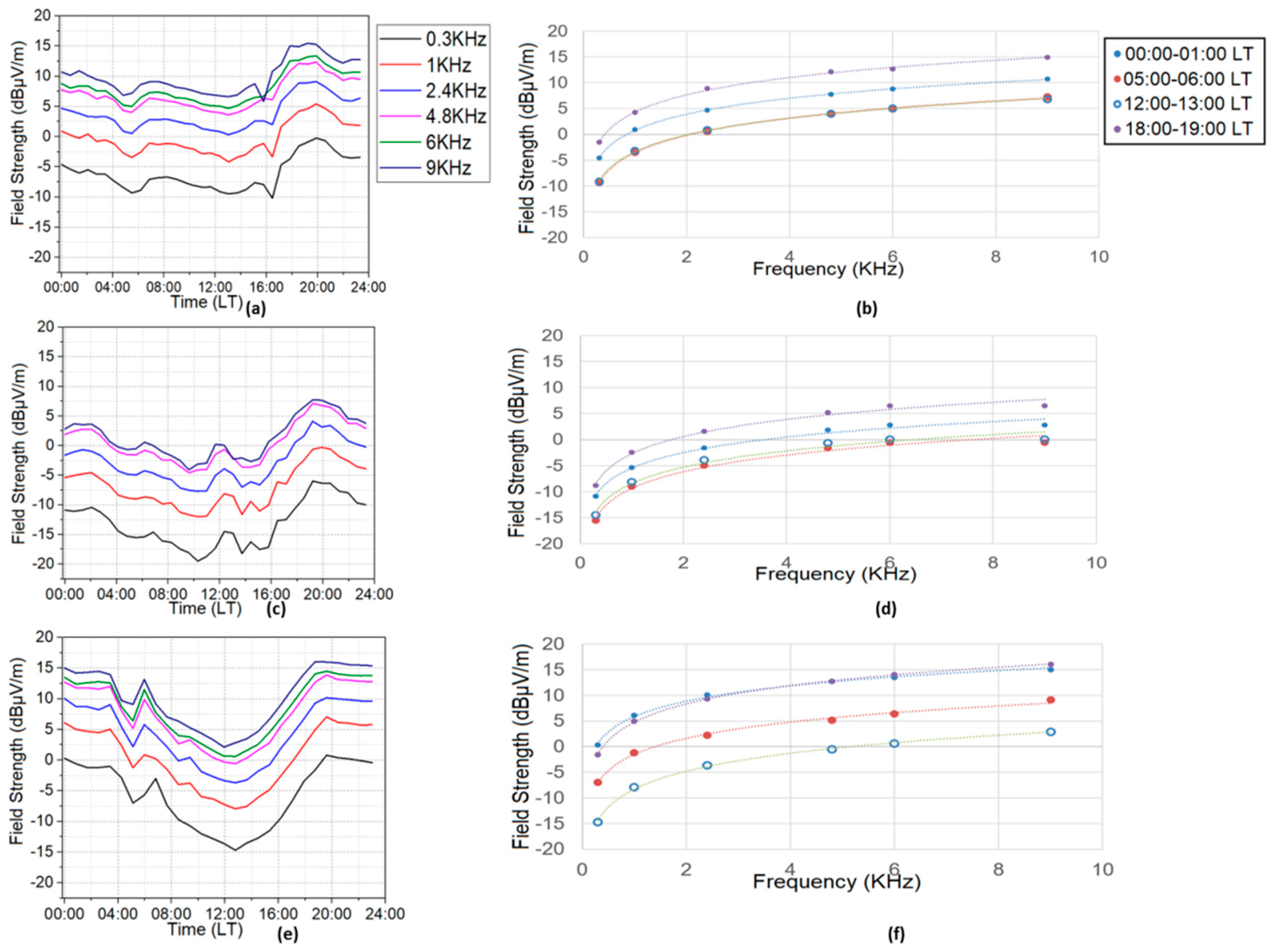HF Noise Characteristics over Cyprus
Abstract
:1. Introduction
2. HF Noise Measurements
3. HF Noise Characteristics Diurnal and Azimuthal Characteristics
3.1. Diurnal Characteristics
3.2. Azimuthal Characteristics
3.3. Bandwidth Characteristics
4. Conclusions
Author Contributions
Funding
Data Availability Statement
Conflicts of Interest
References
- Hagn, G.; Stehle, R.; Harnish, L. Shortwave broadcasting band spectrum occupancy and signal levels in the continental United States and Western Europe. IEEE Trans. Broadcast. 1988, 34, 115–125. [Google Scholar] [CrossRef]
- Economou, L.; Haralambous, H.; Green, P.; Gott, G.; Laycock, P.; Broms, M.; Boberg, S. Aspects of HF spectral occupancy. In Proceedings of the Eighth International Conference on HF Radio Systems and Techniques, Venue University of Surrey, Guildford, UK, 10–13 July 2000. [Google Scholar]
- Pederick, L.H.; Cervera, M.A. Modeling the interference environment in the HF band. Radio Sci. 2016, 51, 82–90. [Google Scholar] [CrossRef] [Green Version]
- Economou, L.; Haralambous, H.; Pantjairos, C.; Green, P.; Gott, G.; Laycock, P.; Bröms, M.; Boberg, S. Models of HF spectral occupancy over a sunspot cycle. IEE Proc. Commun. 2005, 152, 980–988. [Google Scholar] [CrossRef]
- Mostafa, G.; Tsolaki, E.; Haralambous, H. HF Spectral Occupancy Time Series Models Over the Eastern Mediterranean Region. IEEE Trans. Electromagn. Compat. 2016, 59, 240–248. [Google Scholar] [CrossRef]
- Haralambous, H.; Papadopoulos, H. 24-Hour Neural Network Congestion Models for High-Frequency Broadcast Users. IEEE Trans. Broadcast. 2009, 55, 145–154. [Google Scholar] [CrossRef]
- Haralambous, H.; Papadopoulos, H. 24-h HF Spectral Occupancy Characteristics and Neural Network Modeling over Northern Europe. IEEE Trans. Electromagn. Compat. 2017, 59, 1817–1825. [Google Scholar] [CrossRef]
- Cecil, D.J.; Buechler, D.E.; Blakeslee, R.J. Gridded lightning climatology from TRMM-LIS and OTD: Dataset description. Atmos. Res. 2014, 135–136, 404–414. [Google Scholar] [CrossRef] [Green Version]
- Coleman, C.J. A direction-sensitive model of atmospheric noise and its application to the analysis of HF receiving antennas. Radio Sci. 2002, 37, 3-1–3-10. [Google Scholar] [CrossRef] [Green Version]
- Kotaki, M. Global distribution of atmospheric radio noise derived from thunderstorm activity. J. Atmos. Terr. Phys. 1984, 46, 867–877. [Google Scholar] [CrossRef]
- Watterson, C.C.; Juroshek, J.R.; Bensema, W.D. Experimental confirmation of an HF channel model. IEEE Trans. Commun. Technol. 1970, 18, 792–803. [Google Scholar] [CrossRef]
- Ibukun, O. Measurements of atmospheric noise levels. Radio Electron. Eng. 1964, 28, 405–415. [Google Scholar] [CrossRef]
- Ibukun, O. Structural aspects of atmospheric radio noise in the tropics. Proc. IEEE 1966, 54, 361–367. [Google Scholar] [CrossRef]
- Giesbrecht, J.; Clarke, R.; Abbott, D. An empirical study of the probability density function of HF noise. Fluct. Noise Lett. 2006, 6, L117–L125. [Google Scholar] [CrossRef] [Green Version]
- Lemmon, J.J.; Behm, C.J. Wideband HF Noise/Interference Modeling Part I: First-Order Statistics; Technical Report 91-277; U.S. Department of Commerce, National Telecommunications and Information Administration (NTIA): Washington, DC, USA, 1991.
- Lemmon, J.J.; Behm, C.J. Wideband HF Noise/Interference Modeling Part II: Higher-Order Statistics; Technical Report 93-293; U.S. Department of Commerce, National Telecommunications and Information Administration (NTIA): Washington, DC, USA, 1993.
- Lemmon, J.J. Wideband model of HF atmospheric radio noise. Radio Sci. 2001, 36, 1385–1391. [Google Scholar] [CrossRef]
- Ward, B.; Golley, M. Solar cycle variations in atmospheric noise at HF. In Proceedings of the Fifth International Conference on HF Radio Systems and Techniques, Edinburgh, UK, 22–25 July 1991; IET: Edinburgh, UK, 1991; pp. 327–331. [Google Scholar]
- Rodriguez, S.P. High-frequency noise and spectrum occupancy measurements for Virginia and Texas with comparisons to International Radio Consultative Committee predictions. Radio Sci. 1997, 32, 2075–2082. [Google Scholar] [CrossRef]
- Shinde, M.; Gupta, S. A Model of HF Impulsive Atmospheric Noise. IEEE Trans. Electromagn. Compat. 1974, EMC-16, 71–75. [Google Scholar] [CrossRef]
- Pederick, L.H.; Cervera, M.A. A directional HF noise model: Calibration and validation in the Australian region. Radio Sci. 2016, 51, 25–39. [Google Scholar] [CrossRef] [Green Version]
- Georgiou, G. British bases in Cyprus and signals intelligence. Études Helléniques/Hell. Stud. 2011, 19, 121–130. [Google Scholar]
- Posa, L.M.; Materazzi, D.J.; Gerson, N.C. Azimuthal variation of measured HF noise. IEEE Trans. Electromagn. Compat. 1972, 1, 21–31. [Google Scholar] [CrossRef]
- Gibson, A.J.; Arnet, L. Azimuthal Distribution of Noise and Interference at HF. In Proceedings of the 8th International Conference in Antennas & Propagation, Edinburgh, UK, 30 March–2 April 1993. Publication No. 370. [Google Scholar]
- International Radio Consultative Committee (CCIR). Characteristics and Applications of Atmospheric Radio Noise Data; Technical Report 322-3; International Telecommunication Union: Geneva, Switzerland, 1986. [Google Scholar]
- Wong, N.; Gott, G.; Barclay, L. HF spectral occupancy and frequency planning. IEE Proc. F Commun. Radar Signal Process. 1985, 132, 548–557. [Google Scholar] [CrossRef]
- Gott, G.F.; Chan, S.K.; Pantjiaros, C.A.; Brown, J.; Laycock, P.; Broms, M.; Boberg, S. Recent work on the measurement and analysis of spectral occupancy at HF. In Proceedings of the Sixth International Conference on HF Radio Systems and Techniques, Venue University of, York, York, UK, 4–7 July 1994. [Google Scholar]
- Andersson, A. Bandwidth and range dependence of HF interference statistics. In Proceedings of the Fifth International Conference on HF Radio Systems and Techniques, Edinburgh, UK, 22–25 July 1991. [Google Scholar]
- Array Solutions Website. Available online: https://www.arraysolutions.com/ (accessed on 30 October 2022).









| Code | Primary Users | Frequency (MHz) | Code | Primary Users | Frequency (MHz) |
|---|---|---|---|---|---|
| 1 | FIXED/MOBILE | 1.606–1.810 | 49 | FIXED/MOBILE | 13.800–14.000 |
| 2 | AMATEUR | 1.810–1.850 | 50 | AMATEUR | 14.000–14.350 |
| 3 | FIXED/MOBILE | 1.850–2.045 | 51 | FIXED/MOBILE | 14.350–15.000 |
| 4 | FIXED/MOBILE | 2.045–2.300 | 52 | AEROMOBILE | 15.000–15.100 |
| 5 | FXD./MOB./BCST. | 2.300–2.500 | 53 | BROADCAST | 15.100–15.600 |
| 6 | FIXED/MOBILE | 2.500–2.850 | 54 | FIXED | 15.600–16.000 |
| 7 | AEROMOBILE | 2.850–3.155 | 55 | FIXED | 16.000–16.360 |
| 8 | FIXED/MOBILE | 3.155–3.200 | 56 | MARITIME/MOB. | 16.360–16.860 |
| 9 | FXD./MOB./BCST. | 3.200–3.400 | 57 | MARITIME/MOB. | 16.860–17.410 |
| 10 | AEROMOBILE | 3.400–3.500 | 58 | FIXED | 17.410–17.550 |
| 11 | FXD./MOB./AMTR. | 3.500–3.800 | 59 | BROADCAST | 17.550–17.900 |
| 12 | FIXED/MOBILE | 3.800–3.900 | 60 | AEROMOBILE | 17.900–18.030 |
| 13 | AEROMOBILE | 3.900–3.950 | 61 | FIXED | 18.030–18.068 |
| 14 | FIXED/BCST. | 3.950–4.000 | 62 | AMATEUR | 18.068–18.168 |
| 15 | MARITIME/MOB. | 4.000–4.438 | 63 | FIXED/MOBILE | 18.168–18.780 |
| 16 | FIXED/MOBILE | 4.438–4.650 | 64 | MARITIME/MOB | 18.780–18.900 |
| 17 | AEROMOBILE | 4.650–4.750 | 65 | FIXED | 18.900–19.300 |
| 18 | FXD./MOB./BCST. | 4.750–5.060 | 66 | FIXED | 19.300–19.680 |
| 19 | FIXED/MOBILE | 5.060–5.480 | 67 | MAR/MOB | 19.680–19.800 |
| 20 | AEROMOBILE | 5.480–5.730 | 68 | FIXED | 19.800–20.000 |
| 21 | FIXED/MOBILE | 5.730–5.950 | 69 | FIXED/MOBILE | 20.000–20.500 |
| 22 | BROADCAST | 5.950–6.200 | 70 | FIXED/MOBILE | 20.500–21.000 |
| 23 | MARITIME/MOB. | 6.200–6.525 | 71 | AMATEUR | 21.000–21.450 |
| 24 | AEROMOBILE | 6.525–6.765 | 72 | BROADCAST | 21.450–21.870 |
| 25 | FIXED/MOBILE | 6.765–7.000 | 73 | AEROMOBILE | 21.870–22.000 |
| 26 | AMATEUR | 7.000–7.100 | 74 | MAR/MOB | 22.000–22.400 |
| 27 | BROADCAST | 7.100–7.300 | 75 | MAR/MOB | 22.400–22.855 |
| 28 | FIXED/MOBILE | 7.300–7.800 | 76 | FIXED | 22.855–23.000 |
| 29 | FIXED/MOBILE | 7.800–8.195 | 77 | FIXED/MOBILE | 23.000–23.200 |
| 30 | MARITIME/MOB. | 8.195–8.500 | 78 | AEROMOBILE | 23.200–23.350 |
| 31 | MARITIME/MOB. | 8.500–8.815 | 79 | FIXED/MOBILE | 23.350–24.000 |
| 32 | AEROMOBILE | 8.815–9.040 | 80 | FIXED/MOBILE | 24.000–24.500 |
| 33 | FIXED | 9.040–9.500 | 81 | FIXED/MOBILE | 24.500–24.890 |
| 34 | BROADCAST | 9.500–9.900 | 82 | AMATEUR | 24.890–25.000 |
| 35 | FIXED | 9.900–10.000 | 83 | MAR/MOB | 25.000–25.210 |
| 36 | AEROMOBILE | 10.000–10.100 | 84 | FIXED/MOBILE | 25.210–25.550 |
| 37 | FIXED/AMATEUR | 10.100–10.150 | 85 | RAD/ASTR | 25.550–25.670 |
| 38 | FIXED/MOBILE | 10.150–10.600 | 86 | BROADCAST | 25.670–26.100 |
| 39 | FIXED/MOBILE | 10.600–11.175 | 87 | MAR/MOB | 26.100–26.175 |
| 40 | AEROMOBILE | 11.175–11.400 | 88 | FIXED/MOBILE | 26.175–26.500 |
| 41 | FIXED | 11.400–11.650 | 89 | FIXED/MOBILE | 26.500–27.000 |
| 42 | BROADCAST | 11.650–12.050 | 90 | FIXED/MOBILE | 27.000–27.500 |
| 43 | FIXED | 12.050–12.230 | 91 | FXD./MOB./METR. | 27.500–28.000 |
| 44 | MARITIME/MOB. | 12.230–12.730 | 92 | AMATEUR | 28.000–28.500 |
| 45 | MARITIME/MOB. | 12.730–13.200 | 93 | AMATEUR | 28.500–29.000 |
| 46 | AEROMOBILE | 13.200–13.360 | 94 | AMATEUR | 29.000–29.700 |
| 47 | FIXED/MOBILE | 13.360–13.600 | 95 | FIXED/MOBILE | 29.700–30.000 |
| 48 | BROADCAST | 13.600–13.800 |
| Date | Time (LT) | Coefficients | ||
|---|---|---|---|---|
| a | b | R2 (Regression Coefficient) | ||
| 16 May | 00:00–01:00 | 4.4681 | 0.811 | 0.9998 |
| 05:00–06:00 | 4.8137 | 3.5286 | 0.9997 | |
| 12:00–13:00 | 4.6687 | 3.3405 | 0.9996 | |
| 18:00–19:00 | 4.8339 | 4.3205 | 0.9986 | |
| 17 May | 00:00–01:00 | 4.2812 | 5.4494 | 0.9859 |
| 05:00–06:00 | 4.6309 | 9.3809 | 0.9831 | |
| 12:00–13:00 | 4.5166 | 8.4263 | 0.9793 | |
| 18:00–19:00 | 4.756 | 2.7083 | 0.9866 | |
| 18 May | 00:00–01:00 | 4.3306 | 5.8475 | 0.9968 |
| 05:00–06:00 | 4.5531 | 1.5364 | 0.9954 | |
| 12:00–13:00 | 5.0691 | 8.3228 | 0.9985 | |
| 18:00–19:00 | 5.165 | 4.7453 | 0.9996 | |
Publisher’s Note: MDPI stays neutral with regard to jurisdictional claims in published maps and institutional affiliations. |
© 2022 by the authors. Licensee MDPI, Basel, Switzerland. This article is an open access article distributed under the terms and conditions of the Creative Commons Attribution (CC BY) license (https://creativecommons.org/licenses/by/4.0/).
Share and Cite
Haralambous, H.; Constantinides, A.; Paul, K.S. HF Noise Characteristics over Cyprus. Remote Sens. 2022, 14, 6040. https://doi.org/10.3390/rs14236040
Haralambous H, Constantinides A, Paul KS. HF Noise Characteristics over Cyprus. Remote Sensing. 2022; 14(23):6040. https://doi.org/10.3390/rs14236040
Chicago/Turabian StyleHaralambous, Haris, Antonios Constantinides, and Krishnendu Sekhar Paul. 2022. "HF Noise Characteristics over Cyprus" Remote Sensing 14, no. 23: 6040. https://doi.org/10.3390/rs14236040






